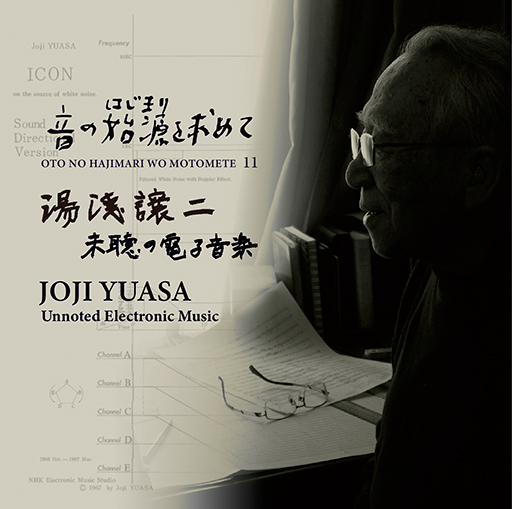
音の始源を求めて 11
湯浅譲二
未聴の電子音楽
The Beginnings of
Japanese Electroacoustic Vol.11
JOJI YUASA
Unnoted Electronic Music
- 《プロジェクション・エセンプラスティク》 1964年
“PROJECTION ESEMPLASTIC WITH WHITE NOISE” 1964 - 《ホワイト・ノイズによる「イコン」》 1967年
““ICON” ON THE SOURCE OF WHITE NOISE” 1967 - 《ヴォイセス・カミング》 1969年
“VOICES COMING” 1969 - 《マイ・ブルー・スカイ 》 1976年
“MY BLUE SKY” 1976 - 《NHKホールの開演ベル》 1973年
“OPENING BELL at NHK HALL” 1973 - 《沖縄海洋博メインパビリオンの音楽》 1975年
“MUSIC FOR THE MAIN PAVILION OF THE OKINAWA OCEAN” 1975
内容紹介
- 1.「プロジェクション・エセンプラスティク」 (1964)
- NHKにおいて電子音楽を制作することになった時、西洋の電子音楽の、電子音を積み重ねて音楽を構成するという考え方ではなく、
もともと全ての周波数を含むホワイト・ノイズのみを用いて、そこから様々な成分を切り出して音響を構成した。 - 2.「ホワイト・ノイズによる「イコン」」(1967)
- この曲もホワイト・ノイズが素材に用いられているが前曲を発展させて、マルチ・チャンネル方式が採用された。
オリジナル版は、五角形に配置されたスピーカの内側に位置する聴衆の周りを、様々な幅(たとえば3つのスピーカを同時に鳴らす等)をもった幾つもの音像が異なった速度で移動する。 - 3.「ヴォイセス・カミング」 (1969)
- 一体何が人間を規定するのか、を考えると音楽の発生も人間の声の発生も同時にあると思った。
言語の発生、つまり私と私以外のものを決める、つまり、私と、それ以外のもの。人間の言葉、言語の三部作 - 4.「マイ・ブルー・スカイ」 (1976)
- 電子音楽作品は既に数多く制作され、いろいろな技法が使われていたなかで、まだ新しい表現が出来ると考えこの作品を制作。
正弦波にゲートを掛け、ゲートの周期やゲートの幅、原音の正弦波の周波数等を、それぞれ変化させたときの周期のずれにより誘導されるビート(beat)音を生に使用した表現力が追求されている。 - BONUS TRACKS
- 5.「NHKホールの開演ベル」 (1973)
- 6.「沖縄海洋博メインパビリオンの音楽」 (1975)
Introduction
- 1. “PROJECTION ESEMPLASTIC WITH WHITE NOISE” (1964)
- When I was asked to create electronic music for NHK, I decided to use only white noise, which originally contained all frequencies, and cut out various components from it to compose the sound, instead of the idea of Western electronic music, in which electronic sounds are piled up to compose music.
- 2. ““ICON” ON THE SOURCE OF WHITE NOISE” (1967)
- Also uses white noise as a material, but it was developed from the previous piece and a multi-channel system was adopted. In the original version, several sound images of different widths (e.g. three loudspeakers playing simultaneously) move at different speeds around the listener, who is positioned inside the pentagonal loudspeakers.
- 3. “VOICES COMING” (1969)
- When I thought about what exactly defines a human being, I felt that the production of music and the production of the human voice are both present at the same time. There is also the production of speech, which defines the self and the other. Human communication consists of a trilogy of languages.
- 4. “MY BLUE SKY” (1976)
- While many works of electronic music had already been created and various techniques had been used, I created this work because I thought I could still create a new form of expression. The work pursues expressiveness through the use of beat sounds obtained by periodically shifting sine waves through a gate and varying the gate period, gate width, frequency of the original sine wave, and other factors.
- BONUS TRACKS
- 5. “OPENING BELL at NHK HALL” (1973)
- 6. “MUSIC FOR THE MAIN PAVILION OF THE OKINAWA OCEAN” (1975)
※トラック5, 6はSoundCloudでの試聴はできません。
BackBUY
- Official Online Shop
- https://sound3.buyshop.jp/items/76522255
- CDに関するお問い合わせ
- denshi-ongaku@sound3.co.jp
Manufacture Distribute by Sound 3 Co., Ltd. (P)2023
制作/有限会社 サウンドスリー
企画/大阪芸術大学音楽工学OB有志の会
Sound 3 Co., Ltd.
#404 Style House Ebisu 3-34-14 Ebisu Shibuya-ku Tokyo Japan zip 150-0013